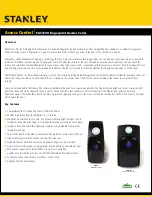
28 / 72
HBC-series V7 LV+MV
Control and additional control by logic signals
Control by logic signal (function A).
The controller can be operated only by logic signal (on / off), applied to the control input "
INP_1
". Speed (power, torque, etc.) in the
on posi-
tion
can be defined by setting the parameters
P19
,
P20
,
P50
(various limits) or the engine goes to the full power. The speed of acceleration
ramp is again given by parameter
P16
“Acceleration”.
Enabling engine running by logic signal (function B).
In case you need switch on / off running of the engine by switch, contact or logical signals, but the speed (power, PWM, ...) are managing by
signal at the input "
INP_1
" or "
INP_2
", auxiliary permitting input (gate) is always carried by the second (for control unused) input or INP_2
INP_1. This gate (permitting) function can be activated by parameter
P4
(control signal
logic signal).
If necessary, this permitting signal (gate) may be also moved to another port, of course, if it is free and available, this is customization.
Start the controller after turning on is determined partly by setting
P5
(safe, fast, immediate), second by the logical state of the control signal
and, if selected "function B" also level of the main control signal (voltage, input PWM, potentiometer).
Galvanic non-isolated control input:
Galvanic isolated control input:
Enabling engine running by logic signal (function C)
– available only for controllers with driving board CN_B15.
Another possibility is to use the management of the port
K20/1
(
PWROFF_INP
- input for emergency disconnection) - of course only if it is not
used just for the emergency disconnect. Which function of this port will be used depends on the parameter
P58
. So if you use this control input
(this function), you can use for control, unlike the B function, both input channels
INP_1
and
INP_2
.
Galvanic non-isolated control input:
Galvanic isolated control input:
Control motor rotation direction by logic signal
(P54)
.
The direction of rotation of the controller can be independently controlled by by logic signal (one direction / opposite direction) on the
RxD
in-
put. This must also correspond with the settings of the parameter
P54
.
Galvanic non-isolated control input:
Galvanic isolated control input:
Of course, if this function is used, you can not use the communication channel RS-232 TTL.
0V
+2.4 to 5V
GND
+3.3V
Switch, read contact,
TTL signal,
resp. voltage 0 up to 24V
Controller HBC- series
INP_1
switch, opto-
coupler, transis-
tor, …
+
–
optical isolation
Controller HBC- series
Control signal
INP_1
K20/1
+3.3V
Switch, read contact,
TTL signal,
resp. voltage 0 up to 24V
Controller HBC- series
PWROFF_INP
switch, opto-
coupler, transis-
tor, …
+
–
optical isolation
Controller HBC- series
Control signal
PWROFF_INP
K20/4
GND
0V
+3.3 to 12V
K20/1
K20/2
+
–
optical isolation
Controller HBC- series
0V
+2.4 to 5V
Control signal
RxD
GND
+3.3V
Switch, read contact,
TTL signal,
resp. voltage 0 up to 24V
Controller HBC- series
RxD
switch, opto-
coupler, transis-
tor, …
















































